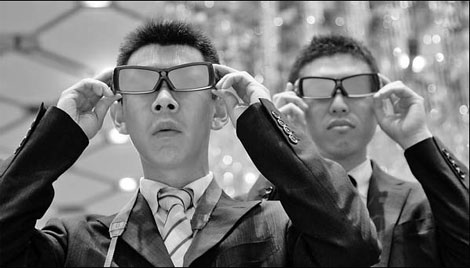3D TV in China: gamble or godsend?
 |
|
Visitors wear 3D glasses at a media preview for 3D TVs in Tokyo in April 2010. |
For makers of three-dimensional (3D) televisions, the Chinese market is a gamble as domestic customers have so far shown little interest in the concept.
However, the increased risk hasn't stopped TV makers from entering the market. Both multinational and domestic manufacturers are preparing to launch more products in China this year. Samsung Group and Sony Corp, the two largest TV makers globally by market share, told China Daily that they will place greater emphasis on the nation's 3D TV market in 2011.
"Samsung hopes to sell 10 million 3D TV units in 2011 and we expect China to become one of our staple markets," said the company in a statement to China Daily.
Sony, which holds approximately 40 percent of the country's 3D market, said that it hopes to increase the 3D TV sector to 35 percent of its total TV sales this year from 10 percent in 2010. "We hope our 3D TV business in China will reach that percentage because it is an important overseas market," said Toshifumi Okuda, senior general manager of Sony's TV division.
Although 3D TV companies are setting aggressive sales targets, the figures in China are not very encouraging.
According to the US-based research company DisplaySearch, the global shipment volume of 3D TVs in the fourth quarter of 2010 was 2.3 million units, a mere 9 percent of its total global TV sales of 7.6 million units.
The figure in China was even worse, according to the domestic research company All View Consulting LLC. It said that 3D TVs accounted for only 2.2 percent of all TVs sold during the Spring Festival holiday, which is always considered a peak shopping period.
Jin Xiaofeng, deputy general manager at All View Consulting, said that nearly all the large Chinese TV manufacturers are planning to launch 3D TVs in China, and the sales volume is expected to reach 3.4 million units this year.
"But price and content are the main barriers for consumers. A 3D TV costs at least twice as much as a normal liquid crystal display (LCD) TV," said Jin. "However, if 3D TVs only cost 20 percent more than the LCD models, sales would rise rapidly."
The cheapest 3D TV on the Chinese market costs more than 18,000 yuan ($2,738). "Many consumers come to our stores and seem interested in the TVs, but few are willing to make a purchase," said a salesman from Suning Appliance Co Ltd, China's largest electronics retailer by sales volume. "Most 3D TV customers are wealthy people or private companies."
Sony told China Daily that the company is focusing on first-tier cities and middle- to high-income consumers.
Applications and content also constrict the sales performance of 3D TVs in China. The country does not have a 3D channel yet, meaning that only movies available in the format can utilize the feature.
"I don't want to wear glasses at home to watch 3D movies. If I want to watch a 3D film, I will simply go to a theater," said Wang Xiaobin, a 29-year-old technology professional in Beijing. "So, why would I need a 3D TV?"
As a response, many manufacturers are developing additional functions for their TVs. Samsung plans to launch the Smart TV, which, in addition to 3D technology, combines Internet access and an online application market.
The Ministry of Industry and Information Technology said earlier this year that it will release two standards which companies will have to meet to refer to their products as "3D" TV, as it aims to regulate and direct the emerging market.
"It is still too early to gauge the market reaction, but I believe that if the price and content issues can be solved, 3D TV will have a prosperous future," said Jin from All View Consulting.
 0
0 






